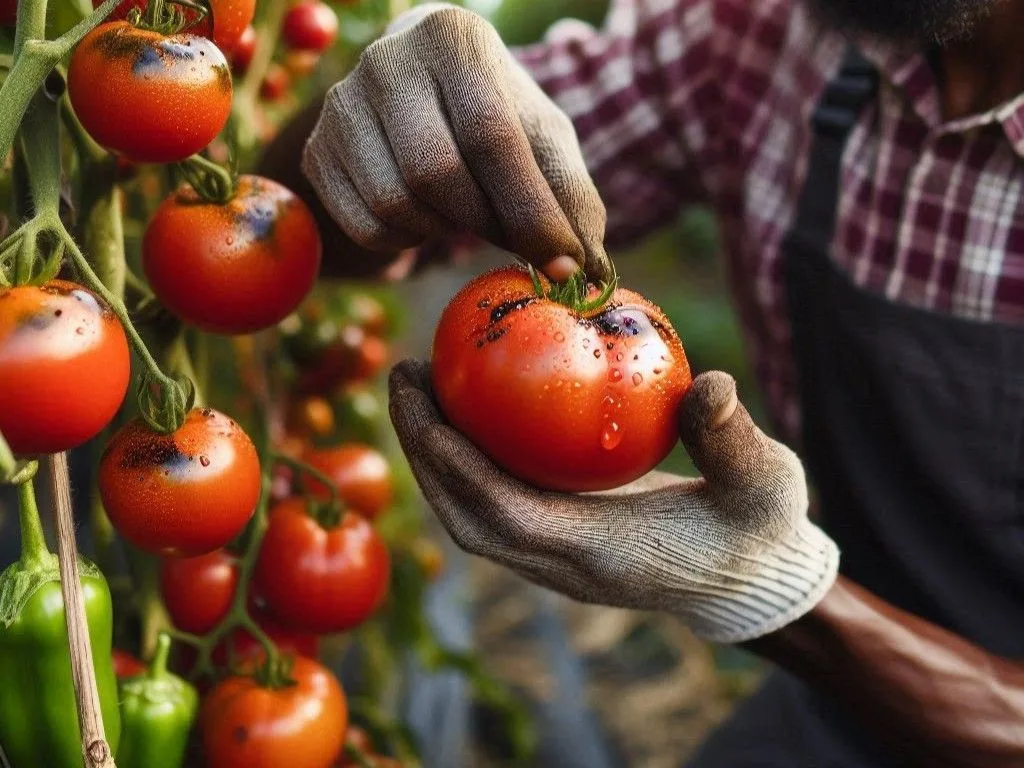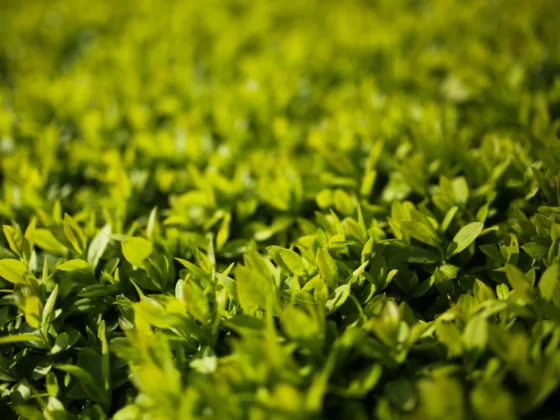Table of Contents Show
Introduction to Tomato Harvesting
Tomato harvesting is more than just a routine task in the garden; it is a deeply satisfying culmination of months of nurturing and care. Gardeners, both seasoned and novice, often look forward to the moment they can finally pick ripe, juicy tomatoes from their carefully tended plants. The vision of perfect, spotless leaves and blemish-free fruits is a common expectation, symbolizing the culmination of their efforts. However, this idealized view frequently clashes with reality.
In the real world, imperfections are part and parcel of gardening. Leaves might show signs of wear, such as black spots or slight discolorations, and fruits may not always be picture-perfect. This can lead to feelings of disappointment and concern among gardeners, particularly those aiming for a flawless harvest. The presence of imperfect leaves can often spark fears about plant health and the overall quality of the harvest, but these imperfections don’t necessarily signify a ruined crop.
Understanding the natural dynamics of tomato growth can help alleviate anxieties about these blemishes. Real gardens are alive with a multitude of variables, influencing the appearance and health of each plant. Environmental factors, minor diseases, and even the robust nature of the plant itself contribute to these visible imperfections. While they may seem alarming, many gardeners find that they do not ultimately impact the taste, nutritional value, or overall yield of their tomatoes.
Accepting these imperfections as a normal part of the gardening process can transform the harvesting experience. Rather than striving for an unattainable vision of perfection, gardeners can focus on the practical and emotional joys of homegrown produce. Embracing the occasional black spot on a leaf as a natural occurrence allows the gardener to appreciate the resilience and versatility of the tomato plant. This shift in perspective can lead to a more rewarding and enjoyable gardening journey, celebrating the real and the imperfect.
Understanding Leaf Imperfections: Black Spots on Tomato Leaves

Black spots on tomato leaves are a common sight for many gardeners, often evoking concern. These imperfections can arise from a multitude of sources, including fungal infections, pests, and environmental stress. While the appearance of these blemishes might be alarming, it’s important to understand that not all black spots spell disaster for your tomato harvest.
One of the primary causes of black spots on tomato leaves is fungal infections. Fungi such as Alternaria, which causes early blight, or Septoria, responsible for Septoria leaf spot, thrive in moist conditions and can lead to dark, necrotic spots on the foliage. Fungal spores are often spread by wind, rain, or even gardening tools, making it challenging to completely avoid exposure. However, ensuring proper spacing between plants and minimizing overhead watering can help reduce the risk.
Pests also contribute to the appearance of black spots on tomato leaves. Insects like aphids, spider mites, or whiteflies can damage the leaves directly or indirectly by spreading diseases. These pests can weaken the plant, leading to the development of tiny, dark spots where the tissues have been compromised. Regularly inspecting the plants and employing natural predators or organic insecticides can mitigate pest issues.
Additionally, environmental stress should not be overlooked. Factors such as inconsistent watering, nutrient deficiencies, or extreme weather conditions can all stress tomato plants and cause symptoms, including black spots. For example, calcium deficiency can lead to blossom end rot, manifesting as dark areas on leaves and fruit. Maintaining a balanced watering schedule and providing necessary nutrients can promote the health and resilience of your plants.
Most importantly, the presence of black spots on tomato leaves does not necessarily indicate a severe or unmanageable problem. These occurrences are relatively common and can often be remedied with attentive care and proactive measures.
By understanding the potential causes and addressing them accordingly, gardeners can continue to nurture robust plants and enjoy a bountiful tomato harvest.
Types of Black Spots: What to Look For
Understanding the different types of black spots that can appear on tomato leaves is crucial for gardeners striving for a healthy harvest. Among the most common culprits are septoria leaf spot, bacterial speck, and early blight. Each of these conditions has distinct characteristics that can help in accurate identification and appropriate management.
Septoria Leaf Spot
Caused by the fungus Septoria lycopersici. This condition is marked by small, water-soaked spots that rapidly develop into dark brown or black spots with a distinctive light gray center. These spots, typically confined to the lower leaves, can coalesce and cause the entire leaf to wither prematurely. High humidity and warm temperatures often enhance the prevalence of septoria leaf spot, making vigilant monitoring essential during such conditions.
Bacterial Speck
Caused by Pseudomonas syringae pv. tomato, manifests as tiny dark specks surrounded by a yellow halo, affecting both leaves and fruit. Unlike fungal spots, bacterial speck lesions are usually superficial and rarely penetrate deeply into the tissue. Cool, damp weather fosters the development of bacterial speck, especially when plants are weak or stressed. The specks can affect the plant’s aesthetics and market value, but with the right management, the overall impact on harvest volume can be minimized.
Early Blight
Attributed to the fungus Alternaria solani, presents as brown to black concentric rings, often referred to as “target spots,” primarily on older leaves. These lesions expand and may eventually lead to complete defoliation if unchecked. Warm, wet weather promotes early blight, making regular inspection and prompt removal of infected foliage imperative to control its spread. Additionally, crop rotation and resistant cultivars can be effective strategies against early blight.
Identifying and understanding these varieties of black spots on tomato leaves are integral to maintaining plant health and ensuring a productive harvest. Each pathogen thrives under specific conditions; knowing these can help gardeners adopt proactive measures to mitigate potential damage.
Impact of Black Spots on Tomato Plants
Black spots on tomato plant leaves can be a source of concern for gardeners, but not all black spots are created equal. While some may indicate potential threats to the health of the plant, others are merely cosmetic blemishes that have little to no impact on the overall vitality of the tomato crop.
At the cosmetic level, black spots may appear due to minor environmental stresses such as inconsistent watering, slight nutrient deficiencies, or benign fungal spores. These types of blemishes do not normally advance to cause severe damage to the plant. In such cases, the aesthetic quality of the leaves may be compromised, but the overall health of the plant and the yield of tomatoes remain largely unaffected.
However, when black spots are symptoms of more serious issues, such as bacterial or fungal diseases, the stakes are higher. Conditions like Septoria leaf spot or bacterial speck can lead to significant leaf damage, eventually impacting photosynthesis and plant vigor. Extensive leaf damage can restrict the plant’s ability to produce energy, thereby reducing growth and fruit yield. Moreover, a weakened plant is more susceptible to additional stresses and secondary infections, which can compound problems.
It is crucial to monitor the extent and progression of the black spots closely. If blemishes remain localized and minimal, it is usually not a cause for alarm. Most healthy tomato plants can tolerate minor leaf spotting without significant detriment to their overall performance. Conversely, if the spotting spreads rapidly or is accompanied by other symptoms such as yellowing leaves, wilting, or fruit deformities, it may be necessary to implement control measures.
In conclusion, while not all black spots signify an urgent threat, understanding the difference between cosmetic and pathogenic blemishes is essential. By carefully observing the plants and responding promptly to signs of severe damage, gardeners can ensure a healthy and productive tomato harvest even in the presence of imperfect leaves.
Management and Treatment Options
When dealing with black spots on tomato leaves, a balanced approach combining organic methods, chemical treatments, and sound cultural practices is essential to safeguard your tomato harvest. Various strategies can help mitigate this issue, promoting healthy plant growth and yield.
Organic Treatment Options:
Organic interventions are a viable means of managing black spots, prioritizing the health of both plants and the environment. Neem oil serves as a popular organic fungicide, effective against various fungal infections. Alternatively, a solution comprising 1 tablespoon of baking soda, 1 teaspoon of dormant oil, and 1 teaspoon of mild liquid soap in 1 gallon of water can be sprayed weekly on affected leaves. This mixture helps to alter the pH levels on leaf surfaces, creating an inhospitable environment for fungi.
Chemical Treatment Options:
For more severe infestations, chemical fungicides can provide relief. Products containing chlorothalonil, mancozeb, or copper fungicides have proven to be effective in controlling fungal spread. It’s crucial to follow the manufacturer’s instructions meticulously to prevent damage to the plants and avoid any health risks to consumers.
Preventive Measures:
Proactive measures can significantly reduce the likelihood of black spots on tomato leaves. Ensuring proper spacing between plants enhances air circulation, thus reducing the humidity levels favorable for fungal growth. Additionally, watering practices should be mindful; irrigating at the base prevents water from splashing onto leaves, further curbing fungal proliferation.
Cultural Practices:
Implementing crop rotation and selecting disease-resistant tomato varieties can diminish recurring issues. Crop rotation mitigates soil-borne diseases, as it prevents pathogens from building up in the soil over consecutive planting seasons. Furthermore, starting plants from disease-free seed or buying certified disease-free seedlings offers a strong defense against potential infestations.
By integrating these management and treatment options, gardeners can address black spots on tomato leaves comprehensively. This holistic approach not only treats current infections but also establishes preventative frameworks, fostering robust plant health and optimizing tomato harvests.
Preventive Measures: Keeping Tomato Plants Healthy
Maintaining the health of tomato plants is a multifaceted process that begins with optimal soil management. Ensuring the soil is well-drained, rich in organic matter, and has a balanced pH level can significantly reduce the risk of black spots on the leaves. To enhance soil health, gardeners should consider regular additions of compost and organic fertilizers which not only provide essential nutrients but also improve soil structure and water retention.
Choosing disease-resistant tomato varieties is another crucial step in preventing the occurrence of black spots. Many seed suppliers offer hybrid or heirloom varieties that have been specifically bred for their resistance to common diseases such as early blight, septoria leaf spot, and bacterial spot. Selecting such varieties can preempt the onset of these issues, providing a more robust start for the gardening season.
Proper watering techniques are fundamental to the health of tomato plants. It is important to water at the base of the plant, avoiding overhead watering which can splash pathogens from the soil onto the leaves. Consistent watering schedules that prevent both drought stress and waterlogging are critical. Using mulch around the base of the plants can help regulate soil moisture levels and reduce the spread of soil-borne diseases.
Adequate spacing for airflow is also vital in keeping tomato plants healthy and free from black spots. Crowded plants create a humid environment conducive to the growth of fungal and bacterial pathogens. Therefore, ensure that tomato plants are spaced according to the guidelines for each variety, generally around 18 to 36 inches apart. Pruning lower leaves and suckers can further improve air circulation around the plants, reducing the likelihood of disease proliferation.
By implementing these preventive measures, gardeners can significantly mitigate the risk of black spots on tomato plants, resulting in healthier plants and a more bountiful harvest.
The Bigger Picture: Good Harvest Practices
Gardening is a blend of art and science, demanding a keen understanding of biology and an intuitive sense of environmental stewardship. When it comes to producing a fruitful tomato harvest, the presence of a few black spots on leaves should not overshadow the holistic measures that underpin successful gardening. It’s essential to focus on comprehensive plant health, ensuring robust growth through diligent horticultural practices.
First, employing crop rotation and companion planting mitigates the build-up of soil-borne diseases and pests that often contribute to blemished foliage. Rotating your tomatoes with non-solanaceous crops like beans or corn enriches the soil and reduces the recurrence of pathogens. Moreover, the strategic use of plants such as basil or marigolds, known for their pest-deterring properties, can foster a healthier growing environment.
Maintaining optimal soil health is another cornerstone of a bountiful harvest. Regularly testing soil and amending it with organic matter like compost ensures it remains rich in nutrients and well-draining. Healthy soil fosters vigorous root systems, which in turn support resilient plants capable of withstanding minor adversities, including black spots on the leaves.
Watering practices also significantly impact the vitality of tomato plants. It’s crucial to water at the base of the plant and avoid wetting the foliage to prevent fungal infections. Deep, infrequent watering encourages deeper root growth, enhancing the plant’s access to water and nutrients, and helping to stave off drought stress and subsequent imperfections in the leaves.
Pest and disease management through organic methods, such as introducing beneficial insects and using homemade sprays, can pre-emptively address issues before they escalate. This integrated pest management approach minimizes harm to the ecosystem while maintaining plant health.
Lastly, regular pruning to remove damaged or diseased leaves, proper staking to support plant growth, and ensuring adequate spacing for air circulation are all practices that collectively contribute to robust plant health. These measures collectively foster a thriving tomato garden, where the occasional black spot becomes merely a footnote in the pursuit of a productive and satisfying harvest.
Conclusion: Embracing Imperfection in the Garden
In the world of gardening, striving for perfection can be a double-edged sword. As we’ve explored throughout this blog post, imperfections such as black spots on tomato leaves are a common occurrence and are not indicative of a failing crop. These blemishes often signal benign issues like minor fungal or bacterial infections, nutrient deficiencies, or minor pest damage, rather than systemic problems that might decimate the entire harvest.
Understanding that a few black spots do not necessarily ruin your tomato harvest empowers gardeners to approach horticulture with a more forgiving lens. It alleviates the pressure of achieving an immaculate garden and allows for the enjoyment of the natural growing process. Spotting a blemish is a moment to investigate and possibly learn, not to feel disheartened. Each growing season is an opportunity to gain new insights and improve care techniques, inevitably leading to bountiful yields despite minor imperfections.
Furthermore, these minor imperfections underline the garden’s dynamic ecosystem. The occasional black spot on your tomato leaves is a reminder that the garden is a living, breathing habitat, teeming with life and balanced by a series of natural checks and balances. By embracing these minor flaws, gardeners reinforce the concept that perfection in nature is relative and often unnecessary. Instead, focusing on the overall health and productivity of the plants will yield satisfying and robust results.
Ultimately, the joy of gardening lies in the journey, the nurturing of plants, and the anticipation of a rich harvest. By embracing imperfection, gardeners can take pride in their endeavors, enjoying the fruits of their labor without undue worry. Imperfect leaves, peppered with a few black spots, stand as testaments to a garden well-tended and loved. May your gardening experience be enriched with this understanding, leading you to greener and more fulfilling pastures.










